Joy Neal Kidney's Blog, page 36
June 16, 2023
A Loving Father, the Answer to Prayer for a 12-year-old Boy–Guest post by J.D. Wininger

For the first 14 years of my life, I seldom felt the joy of being loved. I never knew the difference encouragement made in a young life; and never understood how being part of a family was something to cherish. By the time I was 12, I had all but given up on the dream of being truly loved, with one exception. I prayed at night to belong to a family that cared about me. In doing so, I felt sheltered from the reality I had grown all too accustomed to.
God answered my prayers when a Massachusetts family moved to my small central Florida town and adopted me into their family. When the man who would become my earthly dad brought me into his family, my world blossomed. Immersed in a family where my brothers and sister loved and accepted me, I grew to become who God always planned. I was in a world where Mom and Dad taught me true Christianity by their actions; a world where I learned by their example what it meant to be a member of a family. In this environment, they laid the foundation for my life.
I’m blessed that my dad invested over half a century of love, wisdom, and learning into me. When I stop and think about my dad, I’m often overwhelmed by all the blessings he brought into my life through his example of godly living. I will always remember him as being a patient teacher, sharing both life and trade skills. He remained a firm believer in Christ, held a fierce commitment to family, and a dad I want to emulate in my life.

Even though I’m adopted, it amazes me and others at how much we are alike. I sure hope folks can say that about ourselves and our relationship with our heavenly Father.
In what ways are you and your dad alike? How alike are you and your Abba Father? #ChristianDad #LikeHim CLICK TO TWEET
In my mind, there’s no doubt God brought dad into my life as an answer to prayer. Many years ago, I tried to repay the wonderful gift of dad-ship with a poem I wrote for Father’s Day. I’ve realized in the years since, my words were not directed only to my earthly dad, they are repayment for the gift of family from my Heavenly Father. Whether your earthly dad is with you this year or not, know that your Father in Heaven can be there for you always.
My Father’s Arms
When I’m tired, sad, or lonely,
When few others seem to care,
There’s a place I go to get away,
For there are no troubles there.
I can laugh or cry, or fall asleep,
Or all my problems bare.
It’s the one place where I can just be me,
For there are no troubles there.
I love that place, its peaceful warmth,
A place with many charms.
My favorite place in all the world,
Is in my Father’s arms.
-JDW 6/78
Let your dad, whether still with you on this earth or awaiting you in heaven’s glory (like mine is), know how very much he means/meant in your life. I’m forever blessed to say I am my Father’s son.
Happy Father’s Day to all the dads out there; and God’s blessings,

—–
You might like to check out J.D. Wininger’s compelling website.
Here’s his latest 20-minute visit on PJNet, talking about attending the Blue Ridge Mountains Christian Writers Conference.
June 14, 2023
Our Stars and Stripes: A Symbol of Hope and Service
Flag Day
Being a descendant of Betsy Ross, the famous American flag stitcher, was part of my childhood legacy. Sons in the family still choose “Ross” as a middle name. I’m almost certain it’s not true, even though at least two branches of the Wilson family tree still carry the story. And the name.
Betsy Ross was married three times, the first to John Ross. They had no children. During her next two marriages, she had all daughters. One was married to a Wilson, but they don’t connect to the Wilsons in my family tree.
There was no American flag when our first ancestors came to the New World. There was no America yet when a couple of them signed their names to the Mayflower Compact.
Although none of my ancestors actually fought in the Revolutionary War, one sold provisions to the soldiers (and was disowned by the Quakers for that act) and another was a young drummer boy who helped guard prisoners of war.
The Betsy Ross Flag
After the United States of America was born, the Continental Congress established the Stars and Stripes to symbolize the new nation, on June 14, 1777, with one star and one stripe for each state. The stars were to be a symbol of the “new constellation.” In the flag known as the Betsy Ross flag, they formed a circle.
When Francis Scott Key wrote The Star-Spangled Banner in 1814, the flag had fifteen stars and fifteen stripes. The flag grew in size with each additional state, making it an unattractive shape, so four years later Congress decided the number of stripes would remain at thirteen but a new star would be added for each state joining the union.
Iowa became a state in 1846 and by the Civil War there were 34 states. During the Civil War, President Lincoln refused to let the stars for the southern states be dropped from the flag. By the time the war ended, two more stars had been added.
My most recent immigrant ancestors came to America in the 1870s, to escape having sons drafted to fight for the German Kaiser. The American flag was the symbol of the hope of their new life.
The 48-Star Flag
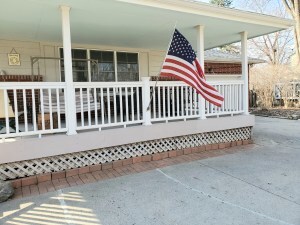 When the Pledge of Allegiance to the flag was first recited in public schools on Columbus Day, 1892, there were 44 stars in the flag. By 1912, there were 48. America flew the 48-star flag when at least four great uncles served in World War I, and when my father and several uncles enlisted for service during World War II.
When the Pledge of Allegiance to the flag was first recited in public schools on Columbus Day, 1892, there were 44 stars in the flag. By 1912, there were 48. America flew the 48-star flag when at least four great uncles served in World War I, and when my father and several uncles enlisted for service during World War II.
During my grade school years, each class recited the Pledge to the Flag, right hands over our hearts, before we began our lessons for the day. Congress added “under God” to the Pledge on Flag Day right after my fourth grade year.
I was in high school when the last two stars were added, for our new states of Alaska and Hawaii. The 50-star flag, the same one we honor today, represented our nation when my husband served in Vietnam.
Danny Wilson’s New Testament
 The American flag is pictured inside small New Testaments given servicemen during World War II. Beneath the flag in one small Testament, saved for decades by my Grandma Leora, in bold handwriting, it says “I give everything for the country it stands for. D. S. Wilson.” Danny Wilson, a P-38 pilot, was killed in action in Austria.
The American flag is pictured inside small New Testaments given servicemen during World War II. Beneath the flag in one small Testament, saved for decades by my Grandma Leora, in bold handwriting, it says “I give everything for the country it stands for. D. S. Wilson.” Danny Wilson, a P-38 pilot, was killed in action in Austria.
All five of the Wilson brothers served in World War II. Only two came home. When I fly the precious Stars and Stripes, I think about those three young brothers who were lost during the war.
I understand that the Pledge of Allegiance isn’t practiced in the public schools much anymore, and that patriotism is passe. Then it’s up to parents and grandparents, aunts and uncles, friends and neighbors to make sure today’s youngsters know just what their freedoms cost.
Tell them why our ancestors were so anxious to risk everything to start over in this nation of hope, which is represented by the Stars and Stripes.
June 12, 2023
Cheetos: A Confession
Last week I attended the Cedar Falls Christian Writers Conference for the first time since 2019. My fibromyalgia symptoms have worsened during the last year so I signed up, not knowing whether I’d be able to attend or not. The closest cabin to the venue was rentable, so I reserved it (for fibromyalgia’s insistent naps).
My favorite chauffeur got us there too early to check in, but in just enough time to try the nearby Dairy Cream. Why doesn’t anyone in the Des Moines area offer black raspberry swirl?
Another health difficulty (I’m a mess, but a blessed one) keeps me from having supper, but I enjoyed connecting with other attendees at the picnic. Then I spied a bag of Cheetos. I was missing out on my decades-long favorite junk food for writers conferences and workshops! (In the old days, I savored them with baloney sandwiches.)

Susan’s husband Mark heard me mention that and later brought me a little bag of them anyway. Hey, I can save it for morning, with the tuna salad I’d brought. What a satisfying breakfast!
After a nap the last day, I returned to the main building. Someone had parked a bag of Cheetos right where I’d left my notebook and shawl (always a shawl). But the gifter from the night before was nowhere around. When he arrived, I asked him about it, but he was innocent. His wife Susan was giggling though. She’s who had stationed them there for me.
I also wanted to meet the wife of one of the presenters. She arrived halfway through lunch, which (for me) was a gluten-free sandwich and Cheetos. My fingers were orange. I tried to expunge the orange from those fingers with a napkin so I could give her a hug. When we eventually got into a conversation about the lack of focus and concentration, I learned she lives holistically and has used herbs and natural remedies. My lunchmates had finished so we sat at the table to keep chatting.
In front of me were half a bag of Cheetos. Well, I wasn’t sure my new friend would approve of them, but I nibbled a few more. More tell-tale orange. I kinda lost interest in my wonderfully salty and crunchy traditional conference companions. Since I’d already consumed a whole bag of them at breakfast and half of one at lunch, I reluctantly tossed the rest.
My favorite chauffeur arrived that afternoon to load up my bedding and all from the cabin. We decided there was time for another black raspberry treat before heading home. Do you suppose that will replace my craving for Cheetos and become our traditional writers conference tradition?
June 7, 2023
My Three Fathers by David LaBelle
On this eve of my 71st birthday, I travel back through the years, wondering what dreams or fears swam through my dear mother’s head and heart as her body prepared to usher me, her second child, into the world from a hospital bed in Orange, California.
I wish I could ask her.

And then, as I sweep nostalgically over the past 7 decades, I consider my three fathers, and how different my life might have been without them.
My First Father
My first father, my biological father, with whom I share both a middle and his last name, taught me practical things like how to drive a car, ride a motorcycle, hunt and work on cars, and most importantly, to love the land.
He was a dreamer, and I inherited his wanderlust, his sense of humor and unfortunately, his blinding temper, among other of undisciplined characteristics. It saddens me to realize I mimicked too many of his selfish actions in my younger years.
Growing up, we lived in constant fear of my father, never knowing when he would come home late at night in a rage, pull us from our beds or spank us for something we did or did not do. I remember several times trembling as he yanked me out of bed late at night and sent me and my siblings out in the shivering darkness in our underwear with flashlights to finish chores he had set for us. I vividly remember one frightening episode when he shouted that he wished we were all in hell. I truly believed he was going to kill us all that night.
As a teenager, I ran away from home several times, once after he chased me with a tire iron, threatening to beat me because I was having fun moving rocks in the creek driveway, something meant to be a punishment. I returned a few days later, after his rage had quieted.
Because of my fear of him, and contempt for the way he treated my mother, I almost killed him after slipping into his bedroom with a loaded pistol while he was sleeping. I pointed the gun at his head. Thankfully, I didn’t pull the trigger.
His example was confusing and often contradictory. He was resourceful, a hard worker, and often helped others in trouble. He taught me many good things. But keeping company with his many good traits, he had a quick and violent temper, and a vengeful spirit.
He believed in ghosts, spirits and flying saucers, and never talked of God, except to curse His name.
I remember as a boy sneaking through a dark night and helping him pour bags of sugar into the gas tank of our neighbor’s tractor because the wealthy and unscrupulous man tried to steal our property. But my dad wasn’t always like that.
In fact, my early years were wonderful, happy times when my father was present, taking me hunting, fishing, and riding motorcycles. We went camping and took family vacations. But through hard financial times and unrealized dreams, a deep bitterness grew to own him. It wasn’t until late in his life, he seemed to have found some peace.
In spite of his sometimes cruel and selfish behaviors, I think he wanted and tried to be a good father. It just felt like he didn’t know how.
He died several years ago at the age of 89.
Though sadly, we were not close much of our lives, we became friends and shared some wonderful times together his last ten years. I told him often how much I loved him, and thanked him for raising me and my siblings in the country, away from the asphalt and noise of the city, where we could run barefoot and learn about nature.
And the man I never heard say he loved me growing up, learned to tell me often he loved me.
My Second Father
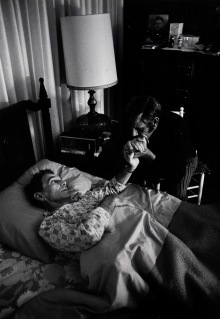 Mason French in 1974 comforting a dying Christian brother.
Mason French in 1974 comforting a dying Christian brother.In most stories of survival, there is usually at least one person, an unselfish soul who offers hope and keeps us from giving up. For me, he was a beautifully imperfect man named Mason French, an angel sent to me during a lonely and dark time in my young life. Though I have been blessed with several mentors, no man has changed the course of my life more profoundly. For 50 years, he has demonstrated what sacrificial and compassionate love looks like.
I was around 21 when I met Mason, a landscaper and preacher,15 years my elder. My brother Steven was living with the French family at the time. Though he had two sons and two daughters, Mason graciously accepted stray souls in need of a home and guidance, much the way a mother cat accepts stray kittens, feeding and protecting them as her own. I immediately fell in love with this man and his family, and he soon became a second father to me, as he was to my brother Steven.
I was jealous of his children. They had a father who played ball with them, talked with them, worked with them, spoke often about God and took them to church. As the Biblical Timothy was to the apostle Paul, I became Mason’s son in the gospel of Christ.
He taught me what love looked like, while patiently introducing me to the person of Jesus. When he talked about Jesus Christ, it was if he knew Him personally. By example, he showed me the meaning of mercy and forgiveness, for others and myself. In fact, it was through him, my second father, I learned to forgive and love my biological father.
 Mason French preaching via Zoom recently
Mason French preaching via Zoom recentlyI once watched him forgive and embrace a man who had deeply hurt him and his family.
That man was me.
There is a famous Biblical seen in the book of Luke often titled “The Prodigal Son.” It reads, “ …and he arose and came to his father. But while he was still a long way off, his father saw him and felt compassion, and ran and embraced him and kissed him.
I have been that son more than once, and hope someday to be that father.
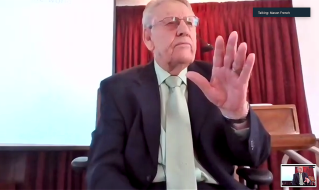
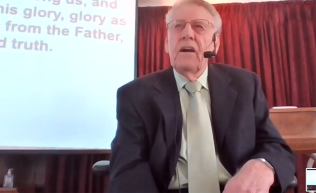
But of the many life-gifts he has given me, no gift has been greater than introducing me to my third Father – my real, eternal Father and Creator, of whose offspring I am.
He is a man of great courage and even greater humility. With a quick wit and sense of humor to match, he remains a great storyteller, powerful speaker and patient teacher.
I have met many people who love God, who would surrender their lives if need be. But I don’t know anybody who respects, cherishes or loves the Word of God more deeply than Mason French.
The Bible says of the virtuous woman, that her children will grow up and call her blessed.
So also, will the children of a good man.
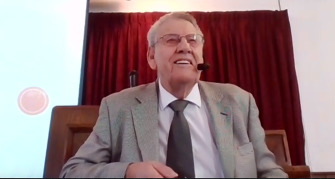
My second father, turned 87 earlier this week, and he continues to contribute to the world as a loving father, grandfather and dedicated gospel preacher.
But just as my biological father died a few years ago at 89, I realize if I live long enough, I will have to face losing my second father, too.
A final thought
Some, the lucky ones, are blessed with caring, loving fathers – guideposts who show the best life paths, teaching their children to navigate a sometimes harsh and confusing world.
Others never know their fathers, raised instead by a single mother, a relative or even by strangers.
So, on this night, 71 years after my mother brought me into this world, my heart is filled with love and gratitude for her and the men, like Mason French, who have been a father to me.
Please check out David LaBelle’s website. And his blog.
Just yesterday, Dave posted this very generous offer. “Once a year I offer a sale on all of my books. This year, on the eve of my 72nd birthday, you can purchase a set of the following books for only $60.00, which includes shipping in the U.S. Please let me know if you would like them personalized. Email: labelledave@gmail.com”
June 5, 2023
Shot Down–the Book and the Audiobook
 Shot Down: The True Story of Pilot Howard Snyder and the Crew of the B-17 Susan Ruth
Shot Down: The True Story of Pilot Howard Snyder and the Crew of the B-17 Susan Ruth
For the first time, the full and complete story of the B-17 Flying Fortress Susan Ruth is shared in unbelievable detail. Author Steve Snyder’s story of his father, Lieutenant Howard Snyder, and the Susan Ruth crew, provides in-depth details about many aspects of World War II few understand or know about. This includes: separation for young families as men went off to war; training before heading to foreign soil; military combat operations; underground and resistance and what Lt. Snyder did when he joined it; and German atrocities toward captured crew and civilians.
I reviewed this fine book a couple of years ago. You may want to consider it was a Father’s Day gift, or a gift to yourself or any fan of World War II history.
 I recently listened to the nearly-nine-hours long audiobook of Shot Down, over a few days. What a rich experience! I especially enjoyed listening as I read along in the book, appreciating the photos and documents. Both the book and the audiobook would make an exceptional Father’s Day gift! There’s an Audible Sample right under the photo.
I recently listened to the nearly-nine-hours long audiobook of Shot Down, over a few days. What a rich experience! I especially enjoyed listening as I read along in the book, appreciating the photos and documents. Both the book and the audiobook would make an exceptional Father’s Day gift! There’s an Audible Sample right under the photo.
You may follow author Steve Snyder on Facebook. He’s also shared his 20-minute story on Our American Stories.
Here is his website.
June 2, 2023
Guthrie County Pioneers arrived June 2, 1855
Are you fascinated by pioneer stories, trying to imagine what it must have been like? Many of the ones I’ve read about said that picking up and moving wasn’t any harder than their lives in general, and that their trek was an adventure. At least the kids thought so.
Ephraim and Lucy Jane Moore would become great grandparents of Leora (Goff) Wilson. When they loaded their two wagons May 6, 1855, to trundle west from Parke County, Indiana, they headed straight for Lucy’s brother’s place in Guthrie County, Iowa. Traveling in two wagons with household goods and six children, ages 3 to 15, the Moores journeyed about a month.
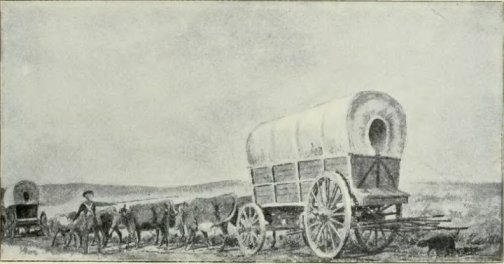 Illustration in History of Iowa From the Earliest Times to the Beginning of the Twentieth Century by Benjamin F. Gue, 1903. (Public Domain)
Illustration in History of Iowa From the Earliest Times to the Beginning of the Twentieth Century by Benjamin F. Gue, 1903. (Public Domain)Conestoga wagons were 15 feet long and emigrant wagons were 10 feet long, as well as narrower and shallower than the Conestogas. My guess is that the Moores traveled in the smaller wagons, with a canvas cover that could be rolled up on the sides so ones riding inside could see the countryside. Every inch of space inside was filled with what they’d need, for cooking along the route as well as what they’d need to start with in their new home.
At twilight, wolves came around, howling their eerie cries. The Moores probably made sure the fire burned all night to keep them away. Did this family travel with others in order to share lookout duties at night?
There were no bridges across the Mississippi River until the late 1860s, so both wagons would have been loaded onto a steam-powered ferry to make the crossing. Just imagine the whinnies, hooves clopping, steam whistle sounding. Or maybe they used oxen. Those details weren’t recorded.
The Moore family arrived in Guthrie County on June 2, 1955, staying with Lucy’s older brother, John Branson, until sometime in August, when they moved to nearby land of their own. At that time, John and Margaret (Mains) Branson had five children of their own, ages 1 to 12. Their pioneer home may still have been fairly primitive, with a couple of rooms with a loft for the children. It was a good thing the Moores arrived during the summer so the kids could spend most of their time outside. But where did everyone sleep?
I read that many times, new pioneers used their wagons as living space for several months, at least a place to sleep. Now I can better imagine how two couples and eleven children shared the Branson pioneer home in 1855.
Six more children were born to Lucy Jane (Branson) Moore, three of whom would die very young, which was always a worry for pioneer families.
—–
Frontierswomen: The Iowa Experience by Glenda Riley
“Life Story of Ephraim W. and Lucy Jane Branson Moore as told by their grand-daughters Laura Jordan Goff and Sadie Moore Parker,” from the Moore Reunion Journal, August 6, 1922
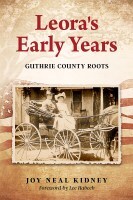 The daughter of Ephraim W. and Lucy Jane (Branson) Moore, Emelia Ann (Moore) Jordan, was the grandmother of Leora (Goff) Wilson. They are mentioned in Leora’s Early Years: Guthrie County Roots.
The daughter of Ephraim W. and Lucy Jane (Branson) Moore, Emelia Ann (Moore) Jordan, was the grandmother of Leora (Goff) Wilson. They are mentioned in Leora’s Early Years: Guthrie County Roots.
June 1, 2023
A Few More Terrific Book Ideas for Father’s Day Gifts
 Immigrant Patriot by Craig Matthews
Immigrant Patriot by Craig Matthews
What an incredible weaving of the immigrant journeys of a young couple, from Scotland and Italy, who meet in Utah after he survives WWI and the influenza pandemic. By then, she is a young widow, who has lost a young brother, her father, her husband in the war, and another brother to the pandemic.
But they have much more to face, from the deception and destruction of a rampant secretive religion. Remarkably, they escape and find redemption. This is the almost unbelievable story of the author’s grandparents, written as a novel.
 Profiles in Kindness by Paul E. Kotz
Profiles in Kindness by Paul E. Kotz
Subtitle: Stories of Inspiration & Everyday Leadership. Chapters are Eye-Openers, New Insights, Inspiration, Everyday Life, and Leadership. All the essays are short, encouraging in sympathetic ways, recognizing that discouragement and failings happen because we all are human beings. These are short and delightful.
Check out Paul’s other compelling books. Paul has also shared stories on Our American Stories.
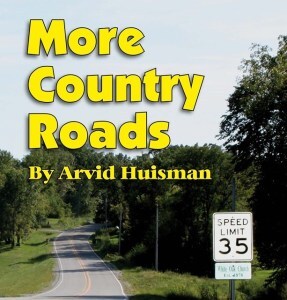 More County Roads by Arvid Huisman
More County Roads by Arvid Huisman
I’ve enjoyed Arvid’s delightful stories for years. For years my sister taught art in Creston, where he was the newspaper publisher. She was always bringing his columns to share. I later discovered he’d published this compilation of some of them. Sure wish you could still get the first volume. Whenever the new issue of Iowa History Journal arrives in the mail, “County Roads” is the first page I turn to.
Arvid has a lively sense of humor, a great memory for details, and such endearing stories.
More Country Roads is available for $16.50 (includes shipping) from Huisman Communications, 9602 Bishop Drive, #59, West Des Moines, IA 50266
 Look Unto the Hills by Dennis L. Peterson
Look Unto the Hills by Dennis L. Peterson
Subtitle: Stories of Growing up in Rural East Tennessee. This is an engaging memoir written in the form of 51 delightful essays, divided into seven sections: Farm Stories, Play, School, Work, People, Animals, and Values. Among the compelling stories is one about what wearing a “hideous sport coat” reveals about a man.
Dennis has told some of his stories for Our American Stories.
 Into the Room by Steven Rogers
Into the Room by Steven Rogers
A reluctant and alcoholic traveler, struggling with the mess he’s left his family in, tours the Holy Land with a bunch of “Holy Rollers.” This masterful and conversational story reveals a man who is rotting from the inside out, step by hesitant step, reach a hopeful transformation.
It’s a powerful novel demonstrating that at the right time, all stories are worth telling. This one certainly is.
The Lincoln Highway in Iowa by Darcy Maulsby
 This is so much more than a history of a highway. It’s stories and people and wonderful places to visit and even have a delicious meal. Heritage along this iconic highway include Meskwaki Code Talkers, crinoid fossils, a shootout with bank robbers, Ben Franklin stores, an Iowa Freedom Rock featuring Dwight Eisenhower in 1919, and one of only three rotary jails remaining (this one called the Squirrel Cage Jail). The Lincoln Highway meanders through Iowa’s Loess Hills, a rich wind-blown soil in only one other place in the world, China.
This is so much more than a history of a highway. It’s stories and people and wonderful places to visit and even have a delicious meal. Heritage along this iconic highway include Meskwaki Code Talkers, crinoid fossils, a shootout with bank robbers, Ben Franklin stores, an Iowa Freedom Rock featuring Dwight Eisenhower in 1919, and one of only three rotary jails remaining (this one called the Squirrel Cage Jail). The Lincoln Highway meanders through Iowa’s Loess Hills, a rich wind-blown soil in only one other place in the world, China.
This book is such fun to read and is a great introduction to do some traveling along this fascinating and historic road.
May 31, 2023
Six Terrific Book Ideas for Father’s Day Gifts, all with Iowa Ties
I chose these books on the strength of their subject matters, but because of the family men behind each important story.
Chuck Long: Destined for Greatness by Aaron Putze
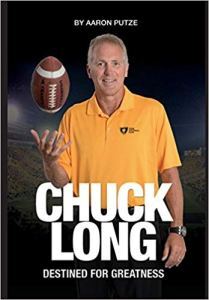
Chuck Long’s enthusiastic but calm take on life and football almost makes me wish I’d been a football fan back in the day. I enjoyed getting acquainted with him especially through his years playing for the Iowa Hawkeyes. There are vignettes throughout of his coaches, Governor Terry Branstad, the Farm Crisis of the 1980s (and Hayden Fry having the team wear ANF stickers–America Needs Farmers), other players, and family members. The book has several photos and is full of anecdotal footnotes. At the end is a salute to sports reporters by Chuck Long. Also tidbits and quotes which “didn’t find a home in the storyline but were too good not to share!” A wonderful story about servant leadership.
When Winter Came: A Country Doctor’s Journey to Fight the Flu Pandemic of 1918
by Mary Beth Sartor Obermeyer
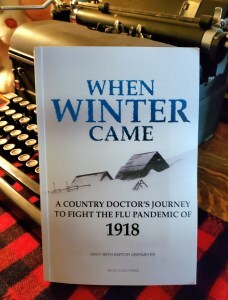
This is an immigrant story, of a sickly boy who was eventually healed. That experience led to medical school, but a longing to serve in a small town setting, using the same kindly medical care he’d experienced led him to northern Iowa. Dr. Pierre Sartor was new in a small Iowa town when the influenza pandemic broke out. He forged a partnership with what is now Mayo Clinic, which was beneficial his entire career.
The author’s father, who at age 12 began driving his father to patients, also became a doctor. Dr. Pierre Sartor’s box of treasures was passed to his son, who later gave it to the author, setting her on an exciting journey of discovery. She reveals even more of that at the end of the book. An important chapter in Iowa history, medical history, and of a well-loved Iowa country doctor, who had immigrated from Luxembourg. A beautiful book.
The author’s recent interview by John Busbee on The Culture Buzz.
Wilhelm’s Way: The Inspiring Story of the Iowa Chemist Who Saved the Manhattan Project
by Teresa Wilhelm Waldof
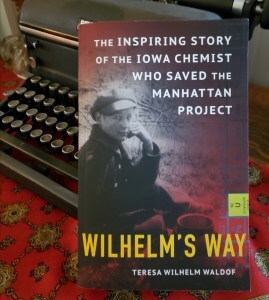
This is a story important to world history, to WWII history, to Iowa history, to the history of Iowa State University. But it’s also a masterfully written family story of the humble man who indeed influenced the outcome of WWII. His efforts were too late for my mother’s three brothers, but my dad–the commander of a B-29 Superfortress with orders for Saipan in September 1945 was spared combat.
Wilhelm’s Way also includes photos, extensive notes, a bibliography, and an index.
Joe Dew: A Glorious Life by Elaine Briggs
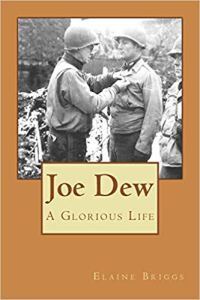
This is the story of an amazing man who grew up during the Depression Era, who had such drive and determination to travel however he could to look for work. My mother graduated from Dexter two years before Joe Dew graduated from Redfield, both small rival towns, so I really enjoyed learning about earlier years of Redfield, Dexter, and Stuart.
Joe Dew’s WWII years are especially compelling, and that he survived combat and the Battle of the Bulge–with a Purple Heart, Distinguished Service Cross, and Bronze Star. The G.I. Bill enabled him to finish college in Ames, then work for General Motors.
The Appendices include photos and genealogy, but also patents that Joe Dew has on file in the U.S. Patent Office.
The Good Governor: Robert Ray and the Indochinese Refugees of Iowa
by Matthew R. Walsh
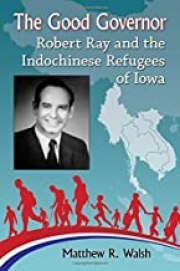
I taught ESL (English as a Second Language) two decades ago, not realizing that the refugee office I often worked with had begun decades earlier by the efforts of Governor Ray. In fact, I ended up working with some of the Hmong women when they arrived in Des Moines in the 1980s.
I was amazed at Kenneth Quinn’s very valuable part in this uniquely Iowan story.
Matthew Walsh’s thorough history of all those years of trips to Indochina, negotiating and working with different presidents, is a fascinating look back at how Iowa in middle of the nation has become such a diverse state. It’s a scholarly book, but also very readable.
Here’s a 16-minute story about the book on Our American Stories.
Missileman: The Secret Life of Cold War Engineer Wallace Clauson
by John Clauson

What a fascinating story on several levels, with roots in small-town Iowa and a terrible accident. Wallace Clauson’s intriguing story is told around his son’s buying a house and his father’s insistence on helping build a fence and a garden. The son can barely believe his father’s revelations about the important part he’d played in world events, but memories come to him that begin to make sense. And his father is dying of cancer.
You’ll learn about Wallace Clauson’s connections with John Atanasoff, early computers, Nuclear missiles, the Cold War, the Yom Kippur War, the Cuban Missile Crisis, secrets, Fermi, Einstein. An incredible biography.
I learned about this history through a 40-minute story on Our American Stories.
May 24, 2023
Why Memorial Day Matters by Lee Habeeb
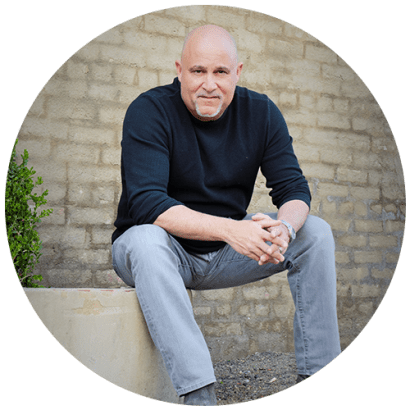 It happens every Memorial Day. I’m drawn back to a day long before I was born: when my mother found out her brother was killed in World War II. It was before there were support groups for such things, before we knew what PTSD was, and before anyone dared to talk about war and the carnage it leaves behind.
It happens every Memorial Day. I’m drawn back to a day long before I was born: when my mother found out her brother was killed in World War II. It was before there were support groups for such things, before we knew what PTSD was, and before anyone dared to talk about war and the carnage it leaves behind.
It was the summer of 1944, and my mother was 12 at the time. A black government car pulled up to her apartment building in West New York, New Jersey. A group of men stepped out of the car and walked up the stairs. A dozen or so families lived in the building, including those who had loved ones volunteering to fight in the war. Her brother John was one of them: he signed up for the army when he was 18.
My mother later remembered praying hard that it would be someone else’s apartment door those men knocked on, and that she felt terrible over praying such a prayer. Then she heard the footsteps stop in front of her family’s apartment door, followed by three firm knocks. She told me she never heard her mom cry so hard when that happened. Her mom didn’t need to open the door to comprehend the news.
My mother’s dad barely cried. Afterwards, she would never again see him truly enjoy his life. He’d lost not just his only son–he’d lost his bloodline and future.
John, the uncle I never knew, is buried at the U.S. Military Cemetery in St. Laurent, France. A framed picture of that cemetery hangs on my office wall, next to a framed Purple Heart citation.
For me and millions of Americans, Memorial Day is a day to look back. It’s a sacred day. Yes it’s also the extended weekend that kicks off the summer with hot dogs and picnics, too. But mornings on Memorial Day were always about honoring those who paid the ultimate sacrifice serving their county in uniform.
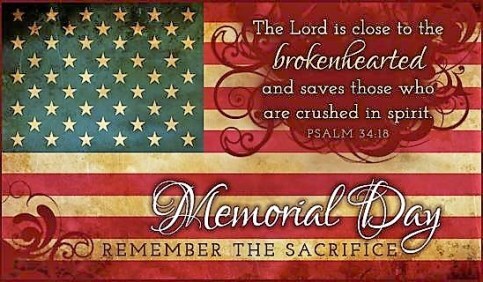
Memorial Day is more than a weekend of fun and sun to so many of us. It’s personal. That’s why it’s about visiting military cemeteries and adorning gravesites with small American flags. . . .
That’s why Memorial Day matters to so many of us. It’s also why it should matter to all of us.
–Lee Habeeb in Newsweek, May 31, 2021, excerpted with permission
Listen as Lee shares his very personal 10-minute story on Our American Stories.
May 22, 2023
The Iowa Soldiers and Sailors Monument on the Capitol Grounds
Iowa Soldiers and Sailors Monument
Murray Johnston was selected to haul the Iowa Soldiers and Sailors Monument in sections on flatbed rail cars from Peoria, Illinois, to Des Moines. Family members, according to Johnston’s granddaughter Phyllis Kennedy Cameron, witnessed the train’s arrival in Des Moines.

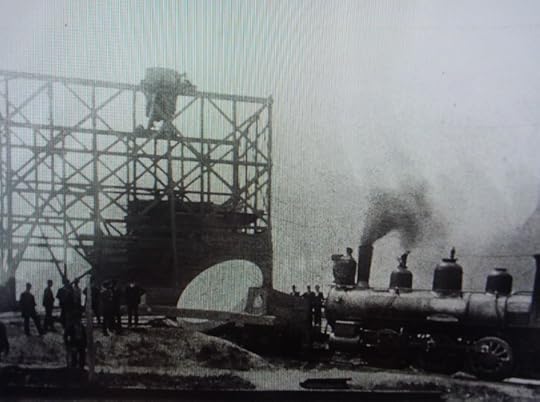
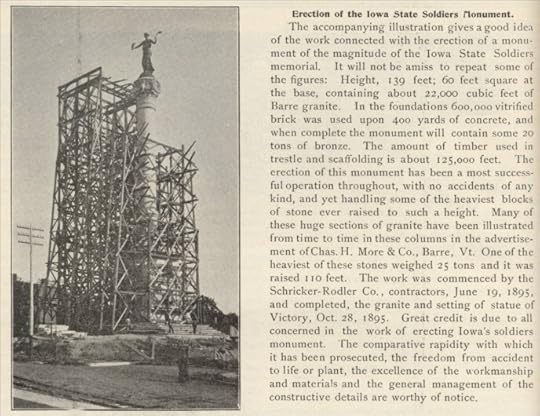

Civil War Veteran
Murray Johnston was only 16 years old when he “heard the call of his country for more soldiers to fight in the great war between the states.” He’d been born in Davenport, Iowa, in 1849, and enlisted there in Iowa Infantry, Company E, 8th Regiment. After the war he enlisted for three more years with the 77th Regiment Infantry of the regular army, serving from 1866-1869.
Rock Island Railroad
 Johnston began working as a railroad fireman for the Rock Island in Davenport, married Mary Bogart in 1874, moved with his family about 1880 to Stuart, Iowa, where they made their home. He worked for the Rock Island Railroad for 42 years. His last run was on the Guthrie branch in 1912–on Engine #344, affectionately called Liza Jane, possibly a Baldwin.
Johnston began working as a railroad fireman for the Rock Island in Davenport, married Mary Bogart in 1874, moved with his family about 1880 to Stuart, Iowa, where they made their home. He worked for the Rock Island Railroad for 42 years. His last run was on the Guthrie branch in 1912–on Engine #344, affectionately called Liza Jane, possibly a Baldwin.
 Picture taken the day of Murray Johnston’s last run on the Liza Jane, Engine No. 344.
Picture taken the day of Murray Johnston’s last run on the Liza Jane, Engine No. 344.—–
Here are more stories about Murray Johnston and the Liza Jane train. Murray and Mary Johnston are buried at Stuart.
Story about the monument from Iowa History Journal.



